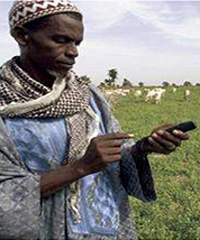Boosting the smartphone in Africa: Strategies by industry players
The high penetration of mobile phones in Africa has been one of its success stories. It has inspired innovations in technology and created new industries, such as mobile payments, to solve Africa-specific problems.

Research firm Informa Telecoms & Media predicts that by 2018 smartphone connections on the continent will rise from 79m in 2012 to 412m.
Yet the penetration of smartphones and other data-enabled devices (such as tablets) remains low on the continent where feature phones dominate. According to global research firm Informa Telecoms & Media, at the end of 2012 smartphones accounted for only 11% of mobile connections on the continent, compared to an almost double estimated global average of 21%.
However Informa predicts around a five-fold increase in the number of smartphone connections by 2018, rising from 79m in 2012 to 412m. A main driver of this growth is the introduction of more affordable smartphones.
In Informa’s report Africa Telecoms Outlook 2014, the firm highlights several strategies implemented by African operators and other industry players to make smartphones more affordable.
Partnering with phone manufacturers
Kenya’s mobile network operator Safaricom has introduced a number of low-cost smartphones into the market. It partnered with chip-maker Intel to launch the Yolo low-cost smartphone, an Android-based device designed for emerging markets. Yolo was launched in January 2013 at a subsidised price of around US$125 and reportedly sold 5,000 phones in two weeks.
Safaricom also partnered with Microsoft to launch the 4Afrika smartphone in May 2013 at around $190. It was developed by Microsoft and Huawei as part of Microsoft’s 4Afrika programme.
Other operators, such as Etisalat, have also commissioned device manufacturers to build handsets, which are then sold under its brand in some African markets.
For example, the P3 low-cost smartphone was introduced by Etisalat Nigeria under its own brand, and manufactured by Chinese mobile phone manufacturer Tecno. And last year Orange also partnered with China-based Spreadtrum Communications with the aim to develop more affordable handsets and smartphones for Orange’s African and European markets.
Added perks through apps and content partnerships
In March 2013, Samsung launched The Kleek, a pan-African mobile music streaming service for African consumers of Samsung smartphones. The company partnered with Universal Music to develop the app specifically to target the African market.
Last year Airtel also teamed up with Nokia and Facebook to allow free Facebook access on Nokia’s low-cost Asha 501 smartphone. While users were only granted access for a limited period of time, it was exclusive to Airtel subscribers in Africa and India.
Device payment plans
Between 2012 and 2013, MTN Nigeria saw a 54% increase in its smartphone customer base and reported that the average revenue per smartphone user is 3.5 times more than non-smartphone users.
To encourage the uptake of smartphones, MTN Nigeria has partnered with Samsung and Standard Chartered Bank to run a device-financing programme where customers can access low-cost loans to purchase Samsung smartphones and tablets. Loans are repayable over three months to a year.
“Partnerships of this kind, between operators, device manufacturers and, in some cases, providers of content and applications, are important mechanisms for encouraging the take-up of smartphone and other data devices in Africa,” says Informa.

